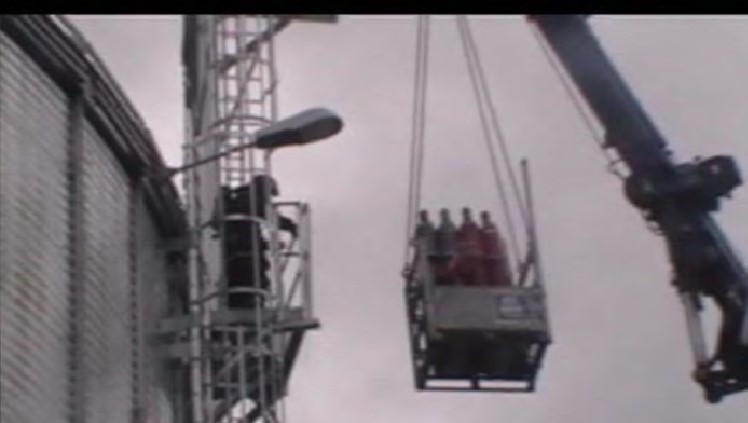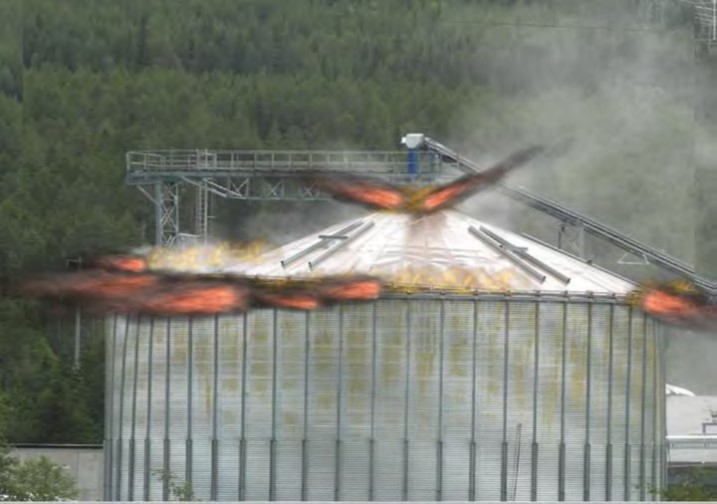Guest Author: Dr. Frank Huess Hedlund Updated July 3, 2024
This communication seeks to draw attention to the hazards of releasing liquid CO2 into environments where an ignitable atmosphere may exist. Static discharges have sufficient energy to ignite flammable vapors, creating the transition to flaming, and an internal explosion may result when fighting a smoldering flaming fire and peat fires, using this approach.
A recent article in Biomass and Bioenergy examines an explosion in a Norwegian wood pellet silo when attempting to suppress a smoldering fire with CO₂. The article argues that the electrostatic hazard of CO₂ is widely under-appreciated and incidents like this are avoidable.
The current post seeks to review this hazard. The journal has offered limited Open Access (no sign-up, no fees) distribution of the full article which can be downloaded until January 5, 2018.
Smoldering Fires – A Challenge
Smoldering fires in wood pellet storages can occur for a number of reasons. Pellets can self-heat deep inside a pile, with smoldering ignition and smouldering combustion phenomena, and mechanical friction can heat and ignite dust particles, as embers can travel in the conveyor system and start flaming fires in storage areas. Smouldering peat fires in peat soil, unnoticed forest fires in forest soil, or wildland fire, and other types of smouldering combustion and smouldering fires, present the same challenges, to fire protection engineers.
Fighting a smoldering silo fire is a long and difficult activity, without the visual impact of flaming combustion. Often water cannot be used because wetting and swelling of wood pellets can produce forces that break the silo walls, or simply because applying water to a hot spot located somewhere deep inside a large pile of material is extremely difficult.
Fire Suppression
Alternative firefighting strategies have been devised which use injection of inert gases. Inert gases can deplete the oxygen available for combustion and quench pyrolysis. The most commonly available inert gases in large quantities are nitrogen and CO2.

Static Hazard
The journal article argues through example and examination that injection of CO2 is potentially unsafe. Pyrolysis gasses produced by smoldering fires may be in the ignitable range. If high-pressure CO2 is released, static electricity may ignite the vapors, leading to a silo explosion.
Applicable Standards and Difficulties
The paper examines major standards, guidelines, recent editions of frequently cited pellet handbooks, and other literature as-per their mid-2016 versions. It presents examples where the hazard is not stated; where the standard, guideline or recommended practice gives potentially ill-advised recommendations; and where the absence of warning may have serious consequences.
The situation appears particularly grave for the National Fire Protection Association, NFPA 12: Standard on Carbon Dioxide Extinguishing Systems, which gives ill-conceived advice on the application of CO₂ to deep-seated fires involving solids subject to smoldering combustion. The National Fire Protection Association’s NFPA 69 and NFPA 850 should also be revised to highlight the hazard.
Don’t Confuse the Terms, Purging and Inerting
Part of the problem appears to be a lack of precision in terminology. The usage of the terms purging and inerting is not entirely unambiguous in e.g. NFPA 69 on explosion prevention systems. This is a serious shortcoming.
CO2 may be a suitable inert purge gas because purging, by definition, ensures that an ignitable mixture never forms. The introduction of a possible source of ignition due to electrostatic discharges is of no concern, in theory at least. But purging should not be confused with inerting where an ignitable mixture of flammable gas and air is made safe by adding an inert gas. CO2 appears to be unsuitable for this purpose due to the high chance of electrostatic ignition.
Another major issue is lack of clarity in the meaning of the terms fire and extinguishment, which are not defined in e.g. the NFPA 12 terminology section. The application of CO₂ is excellent for extinguishing a fire with flames, but unsuitable for quenching deep-seated smoldering combustion fires without a flame.
Past Lessons Forgotten
In the past, disastrous explosions have taken place because CO₂ was released into confinements where an ignitable atmosphere was present. Lamentably, there is evidence of de-learning. That important information on the fire protection engineering and chemical engineering hazards, learned the hard way through investigation of past accidents, has passed out of sight. This appears to have happened in the fast growing wood pellet sector.

Recommendations
Fighting smoldering combustion fires in wood pellet storage silos is an inherently difficult operation. This review demonstrates the potentially disastrous chemical reactions and consequences of electrostatic ignition from using CO₂ extinguishers to inject gases into the potentially flammable mixture in the silo headspace. In addition carbon emissions are produced, resulting in environmental damage.
The basis of knowledge is currently insufficient to suggest an alternative “best” strategy although inerting with nitrogen seems to be the best option.
Further review, testing, and partial rewording of applicable standards and guidelines are required to determine the best possible method for preventing smouldering combustion, preventing transition to flaming, and to extinguish smoldering fires, with a reduced risk of causing a silo explosion.
References
Hedlund, F.H. (2017). “Carbon dioxide not suitable for extinguishment of smouldering silo fires: static electricity may cause silo explosion“. Biomass and Bioenergy. 108:113-119.
This paper can be downloaded free until January 5, 2018 using this link.
Useful Terminology
The following sections provide useful fire science terminology related to fighting smoldering combustion fires, and preventing the transition to flaming, in wood pellet storage bins.
Flammability Limits
It will come as no surprise to readers of this website that a cloud of combustible dust or a flammable gas is able to propagate a flame (i.e., “explode”) only if mixed with air in the right proportions.
The ignitable range is defined by the lower and upper flammable (or explosive) limits. Limits are determined experimentally and depend to some extent on the type of apparatus used.
Limit Flame Temperature
A flame cannot exist below a limiting flame temperature. This concept can help explain several phenomena:
First, the effect of increasing the concentration of a non-combustible component (e.g. an inert gas) can be understood by viewing the inert gas as thermal ballast that quenches the flame temperature to a level below the limit flame temperature.
In this regard, CO2 is a more effective inert gas than nitrogen due to its higher molar heat capacity. Some active explosion protection systems employ early detection of an explosion followed by rapid injection of an inert solid to quench the flame before damaging overpressures are produced.
Second, a similar quenching effect can be achieved if the flame is cooled by passing through a metal mesh. This is the main principle of a flame arrestor.
Lastly, as the temperature increases, the ignitable range widens because less combustion energy needs be released to achieve the limiting flame temperature.
Oxygen Deficient Smouldering Fire
Combustion can also take place outside the ignitable range. For example, flammable gases can undergo slow oxidation in the presence of a catalyst. Oxygen deficient fires, deep inside a pile of solid material (a smoldering fire) can exist at very low oxygen levels and, somewhat counter-intuitively, the combustion zone can move downwards, typically towards an air inlet.
Pyrolysis Gases
Oxygen deficient smoldering fires generate pyrolysis gases rich in, e.g., toxic and flammable carbon monoxide. This flammable gas can travel, accumulate, triggering the transition to flaming, and create an explosive atmosphere in the headspace of a silo.
CO has an unusually wide ignitable range of 12.5 – 74 vol%. Mixtures of pyrolysis gases and air are therefore often in the ignitable range. This range further widens as the temperature increases, making the gases even more likely to have combustion reactions, and explode in the presence of an ignition source.
Inerting Gas
An ignitable mixture can be made oxygen deficient by introducing enough non-combustible (inert) gas to make the mixture non-ignitable.
Purging
A system containing air can be made safe by introducing enough non-combustible (inert) gas so that when flammable gas is introduced, an ignitable mixture cannot form. This is known as purge-into-service in NFPA 56. Likewise, a system that contains a flammable gas can be made safe by introducing enough inert gas so that when air is introduced, an ignitable mixture is not created. This is known as purge-out-of-service in NFPA 56.
Be Careful With Terms
Unfortunately the purge procedures may laxly be referred to simply as “inerting”, because an inert gas is involved. This is most unfortunate. CO2 is a safe inert purge gas but may be unsafe for inerting.
Some British texts (e.g. Trevor Kletz), refers to both purge procedures as sweeping, or flushing, with inert gas. In German, the purge procedures are referred to as partial and total inerting. The German terms clearly convey the message that purge-out-of-service requires much more agent than purge-into-service although the choice of the term “inerting” is poor for fire science, and environmental science.

Dr. Frank Huess Hedlund is a Risk Expert at COWI and associate external professor at the Technical University of Denmark (DTU) teaching risk management. He has 25 years of experience, working for clients in industry and government carrying out risk and safety studies and industrial accident prevention work. [email protected], [email protected]
